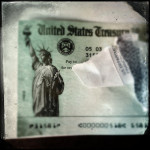People ask, all the time, what’s included in bankruptcy?
Too often, people use “included” to mean “discharged”. That confuses what do you disclose in your schedules with what is discharged at the end of the case.
The short answer to what is included on your paperwork is EVERYTHING, dischargeable or not.
What goes in the bankruptcy schedules
Think of it like this: bankruptcy is a snapshot of your situation on the day the bankruptcy case is filed.
Maybe, think of your bankruptcy like the Clampett’s Buick, arriving in Beverly Hills, crating all their stuff.
For bankruptcy purposes, your case includes your financial “stuff”, debts and assets.
- The debts that are included in the case are those existing on the day you file.
- The assets that are included are the things you owned when you filed bankruptcy.
Bankruptcy doesn’t include
The bankruptcy filing draws a line between your pre bankrutpcy life and your life after bankruptcy.
With a couple of exceptions, whatever you earn after the date you file bankruptcy is not included in your bankruptcy. Generally, retirement accounts are listed, but they are either “not property of the estate” or subject to a generous exemption.
Likewise, if you cause an accident or incur a debt after your case is begun, those debts will not be discharged in your bankruptcy case. They weren’t in the snapshot of your situation when you filed your case.
The exceptions
The Bankruptcy Code has three exceptions to the rule that the bankruptcy estate is made up of what you owned when you filed.
They are
- Assets acquired by inheritance, bequest or devise
- Life insurance proceeds by reason of someone’s death
- Assets acquired by a marital property settlement or judgment
If you acquire the right to any of these kinds of assets within 6 months of the commencement of the case, they are treated as if you had them when your case began. The debtor has an obligation to report such acquisitions to the trustee.
Creditors, not debt balances
Bankruptcy acts on the debtor/creditor relationship. That’s why listing all those who have claims against you is so important in getting your bankruptcy schedules right.
It isn’t generally important to list exactly what you owe a creditor in your schedules. The bankruptcy discharge will wipe out whatever it is you owe on a dischargeable debt.
Remember, you can list and discharge debts where you dispute your liability, so long as you give the creditor notice of your case.
Chapter 13 property
If your bankruptcy case is a Chapter 13, the rules are a lot less clear.
One part of the law says the rights of creditors to repayment are determined by the property you have at filing; another part of the bankruptcy code says that your earning during the case are property of the estate.
While lawyers can spend lots of time parsing the law, for the debtor in 13, the rule that is clear is that dramatic changes in your income may trigger a change to your plan payments.
Elusive assets
The biggest trouble debtors have in listing their assets in the bankruptcy schedules involves intangible assets, like the right to sue for an accident that has already happened, or a claim in a class action.
Tragic consequences of filing bankruptcy without listing her mother’s house
Even though it’s not known at filing whether you will win such a claim, and if you win, how much you will get, the claim is still an asset you own. It has to be listed or you may lose it because you didn’t disclose it.
New day
So your fresh start really begins on the day you file your bankruptcy, not when you get the discharge. Every dollar you now earn is yours.
More
How to review your bankruptcy papers
Debts that survive your bankruptcy
Image courtesy of prewarbuick.com.







[…] bankruptcy planning that you can do after you file bankruptcy. That’s despite the fact that bankruptcy is generally a snapshot of what you own and what you owe on the day you file the […]